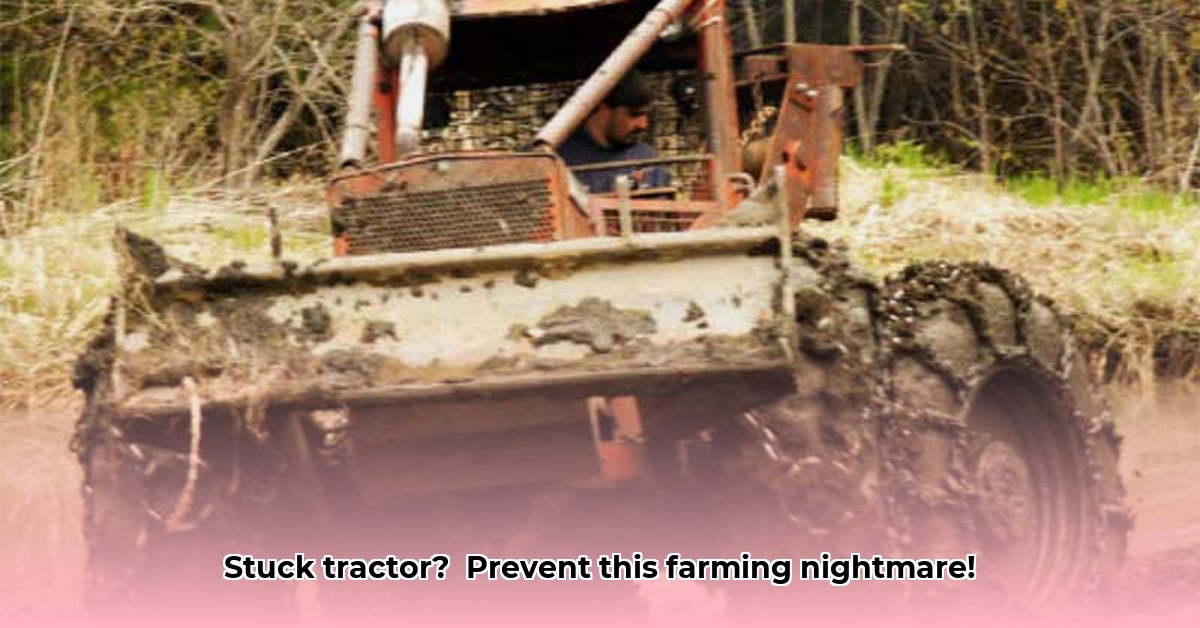
Understanding the Problem: Why Tractors Get Stuck
Nobody wants a tractor stuck in the mud – it's costly, time-consuming, and environmentally damaging. This frustrating situation often stems from a combination of factors impacting soil health and equipment management. Understanding these factors is the first step toward prevention. For more robust tire solutions, check out these heavy-duty inner tubes.
Heavy clay soils, when saturated with water, lose their structural integrity, becoming incredibly difficult for a tractor to traverse. Think of trying to walk across a waterbed – it's all about consistency. The mud's viscosity directly affects traction. Improper tire inflation compounds this problem. Under-inflated tires sink deeper, creating a larger surface area of contact with the mud, reducing the effective force generated by the tires, leading to greater slippage. Conversely, over-inflated tires compact the soil, reducing its ability to support the tractor's weight, making it more prone to sinking, thus exacerbating the issue. Finally, an uneven weight distribution can cause one side of the tractor to sink more easily than the other, leading to imbalance and increased risk of getting stuck. These factors directly impact soil health and sustainable farming practices. Soil compaction, brought on by heavy machinery and poor management, reduces water infiltration, airflow, and root growth – all essential for thriving crops. It severely impacts the long-term productivity of your land.
Preventive Measures: Keeping Your Tractor Rolling
Preventing a stuck tractor requires a multi-pronged approach focusing on soil management, equipment selection, operational techniques, and technology integration.
1. Soil Management: The Foundation of Prevention
- Smart Tillage: Minimize tillage to preserve soil structure and drainage. No-till farming methods (leaving the soil undisturbed) significantly improve soil health and reduce compaction. This practice has been shown to improve water infiltration by as much as 20%.
- Cover Cropping: Planting cover crops strengthens the soil, reducing erosion and providing better support for heavy machinery. Studies show that cover crops increase soil organic matter, making it more resilient to compaction.
- Drainage: Efficient drainage systems are critical, particularly in clay soils prone to waterlogging. Proper drainage significantly reduces the risk of muddy conditions. Implement effective drainage methods such as subsurface drainage or contour farming to ensure adequate water flow and minimize surface water accumulation.
2. Equipment Selection and Maintenance:
- Tire Technology: Low-pressure tires or tracks distribute weight more effectively, minimizing soil contact pressure. This significantly reduces the risk of sinking. Consider using tracks on heavy clay soils, especially in wet conditions, given their superior weight distribution capacity.
- Tractor Selection: Choose a tractor with sufficient power and weight for the job. Overworking a smaller tractor significantly increases the risk of it getting stuck due to excessive wheel slippage.
- Regular Maintenance: Ensure tires are properly inflated and in good working condition. Regular maintenance, including tire pressure checks and overall tractor servicing, is essential to minimize breakdowns and ensure efficient operation. Proper maintenance reduces the risk of mechanical failures that could indirectly lead to a tractor getting stuck.
3. Operational Techniques: Driving Smart in Wet Conditions
- Reduce Speed: Slow and steady wins the race—and protects your soil. Reduce speed significantly in wet conditions to give your tractor’s tires a better chance of maintaining traction. Don't forget how speed directly correlates with the risk of wheel spin.
- Gear Selection: Use lower gears to maintain better control and minimize wheel slippage. Lower gears provide increased torque, improving traction in challenging conditions.
- Avoid Wheel Spin: If you sense wheel slippage, ease off the accelerator, shift to a lower gear, or stop completely. Wheel spin significantly increases soil compaction and the risk of getting stuck.
4. Technology Integration: Precision and Efficiency
- GPS Guidance: GPS-guided systems help minimize overlap and unnecessary passes, reducing soil compaction. GPS guidance allows for precise navigation, minimizing redundant passes that may lead to increased soil disturbance and compaction.
- Yield Monitoring & Soil Sensors: Technology can identify areas with poorer soil conditions, allowing for proactive management and reduced risk of getting stuck. This data-driven approach to farm management supports informed decision-making, reducing the chances of driving through areas prone to mud and compaction.
Recovery Techniques (Brief Overview)
While prevention is best, sometimes tractors do get stuck. If this happens, prioritize safety. Avoid using excessive force. This could further damage the soil and exacerbate the situation. Immediate recovery is key to limiting further damage. Proper recovery board usage or strategically placed planks can help redistribute weight and provide a solid base for traction. If self-recovery is impossible, immediately seek assistance. Remember, quicker recovery often translates into less overall soil disturbance.
Conclusion: Sustainable Practices for Long-Term Success
Preventing tractors from getting stuck is about more than just avoiding inconvenience; it's about safeguarding soil health and ensuring the long-term sustainability of your farm. By implementing these preventive measures, farmers can significantly reduce the risk of tractor entrapment, promote healthier soils, and enhance their overall farm productivity. Healthy soil is the foundation of successful sustainable agriculture. Investing in prevention saves time, money, and the long term health of your farm.